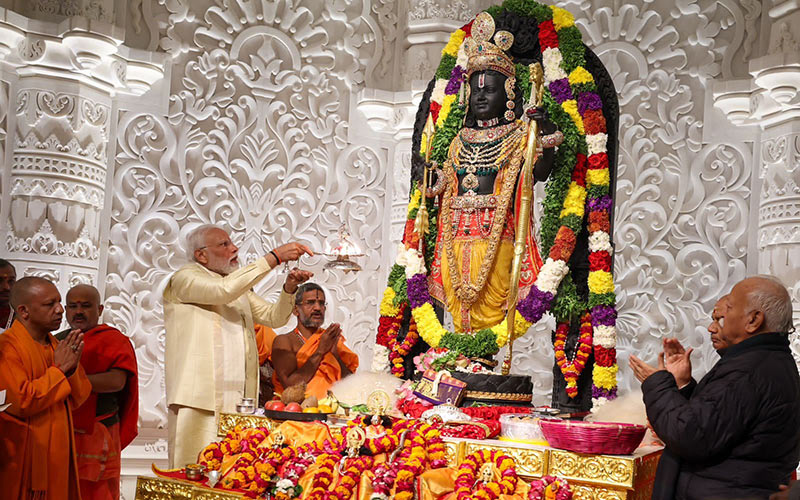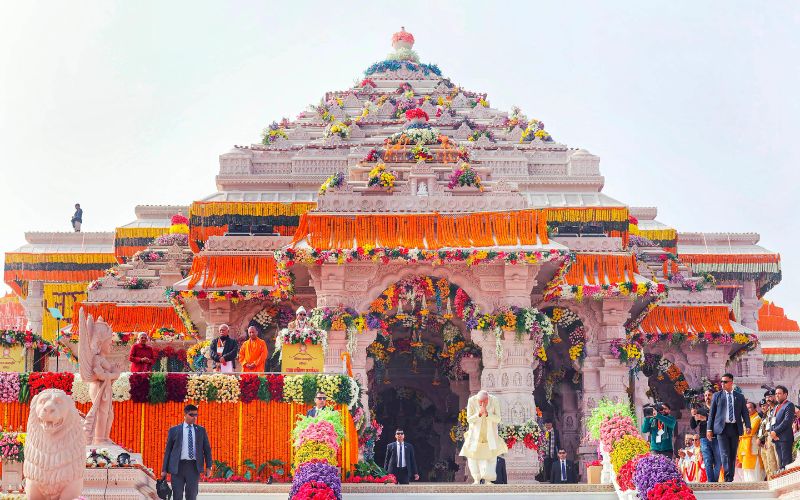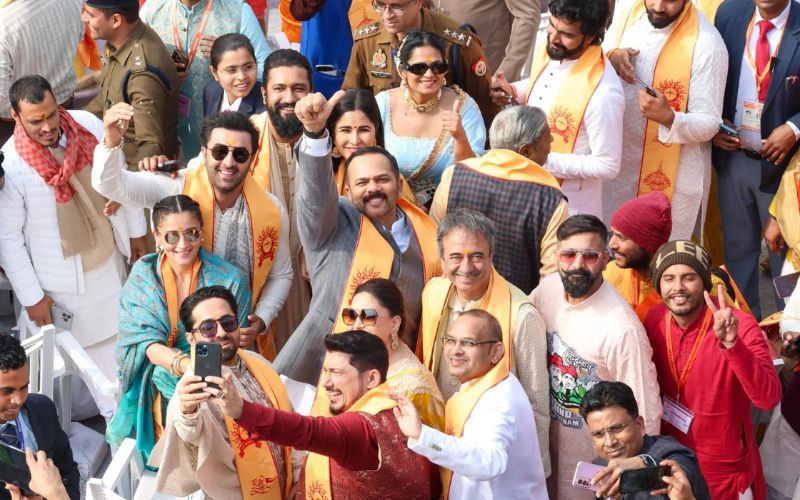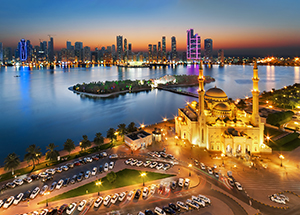January 22’ 2024 was a day of huge historical importance for Hindus not just in India but across the world. This was the day when the Ayodhya temple was inaugurated after a wait of almost 5 centuries. The Grand Ayodhya Temple is dedicated to Lord Sri Ram, who is one of the 10 avatars of Lord Vishnu, the ‘preserver’ in the Hindu Trinity. The day was celebrated with great pomp and splendor not just in Ayodhya but also all over India as well in several parts of the world. Generations of Indians have waited for this moment when they could welcome back Lord Ram to his abode, the place which is considered as his birthplace.
Ayodhya Ram Mandir Inauguration
 Image Credit: indiatoday.in
Image Credit: indiatoday.in
The Ayodhya Ram Mandir Inauguration was done by the Indian Prime Minister, Mr. Narendra Modi. The Prana Pratistha or the consecration process was done in the afternoon of January 22, after which the statue of Lord Ram, fondly known as Ram Lalla, was revealed to everyone. The inauguration was attended by lakhs of devotees, many of them VVIPs who were invited for the ceremony. Plus, the whole ceremony was live streamed for the entire nation and the world.
Which Celebrities Attended Ayodhya Ram Mandir Inauguration?
 Image Credit: ndtv.com
Image Credit: ndtv.com
The Ayodhya Ram Mandir Inauguration Ceremony was a star-studded affair. A whole lot of celebrities, including film stars, sportspersons, artists, politicans, and mystics were a part of this ceremony. From the entertainment industry, stalwarts like Amitabh Bachchan, Rajnikant, Anupam Kher, Jackie Shroff, Chiranjeevi, Mohanlal, and Madhuri Dixit Nene attended the ceremony. The younger generation of the film fraternity were also part of the occasion. Stars like Kangana Ranaut, Ranbir Kapoor, Alia Bhat, Vicky Kaushal, Katrina Kaif, Ayushman Khurrana, Abhishekh Bachchan, Ram Charan, Allu Arjun, Prabhas, and Vivek Oberoi were also a part of it. Filmmakers like Rajkumar Hirani, Subhash Ghai, Rohit Shetty, and Madhur Bhandarkar were present for the ceremony too.
Sachin Tendulkar, Saina Nehwal, Anil Kumble, Ravindra Jadeja, PT Usha, and Mithali Raj represented the sports fraternity at the event. Several celebrated musicians like Sonu Nigam, Shankar Mahadevan, Hariharan, Kailash Kher, Anuradha Paudwal, and 30 such artists entertained the guests with some soulful bhajans praising Lord Ram. Businessmen like Mukesh Ambani (and family), Adani, and Ratan Tata were also present. Arun Govil, Dipika Chikhlia, and Sunil Lahri, who played Ram, Sita, and Lakshman respectively, in Ramanand Sagar’s Ramayana, were the other celebrities at the event.
The saint community was also well represented by the saints and priests from all over India. Swami Chidananda Saraswati, Morari Bapu (Parmarth Niketan’s President), Yoga Guru Swami Ramdev, Spiritual Guru Sri Sri Ravi Shankar, Sadhvi Ritambara, Sri Sri 1008 Acharya Mahamadleshwar, Niranjani Peethadishwar, Yoga Guru Swami Ramdev, Swami Kailashanand, Mahamandaleshwar Avdheshanand, Acharya Pramod Krishnam, Bageshwar Baba, Dhirendra Shastri, and Jagadguru Ramanandacharya were some of the saints who attended the Ram Mandir inauguration ceremony.
History of Ayodhya Ram Mandir
Ayodhya is considered as Ram Janmabhoomi or birthplace of Ram by Hindus. It is believed that Lord Ram was born exactly in the spot where the temple stands today. But the current structure is not the original structure of the Ram temple. Hindus believe that a Ram temple existed here centuries ago. During the rule of Mughal emperor Babar in the 16th century, this temple was destroyed to build a mosque which was named Babri Masjid. Although tensions existed between Hindus and Muslims around the ownership of the place, things came to head on December 6’ 1992 when a group of Hindu nationals destroyed the Babri Masjid. This led to mass violence and communal tensions all over the country. Since then, people from both religious groups have been fighting in court for the possession of the place. In 2019, the Supreme Court ruled in favor of the Hindus stating that research and excavation proved that the masjid was built on the remnants of a Ram temple.
Architecture and Features of Ayodhya Ram Mandir
 Image Credit: prabhatkhabar.com
Image Credit: prabhatkhabar.com
After the supreme court ruling, work on the temple began in August 2020. It took almost 4 years for the Ayodhya Ram Mandir to become a reality. And what a magnificent reality it is! The Ayodhya temple is a grand temple, spread around an area of 2.77 acres and is fit for the great King Ram.
Design and Designer:
An interesting fact about the temple architecture is that the original design of the temple was decided in 1988 itself. The design was made by the Sompura family, who have the legacy of temple craftmanship. In 2020, before the construction of the temple began, few revisions were made to make the design Vastu complaint.
Style and Features:
The architectural style of the temple is Nagra style. This style has existed since the 5th century and is commonly seen in the temples of North India. This temple style has some unique features like pillared portico, temple construction on a raised platform, the main shrine built right in the center of the temple on a rectangular plinth, etc. Apart from these, the temple also has some basic elements that are found in almost all temples.
This temple has a Garba Griha or the sanctum Santorum, the home of the main deity (Lord Ram in this case). Then it has the Mandapa, the assembly hall that faces the Garba Griha. The temple has a Shikhara, which is a mountain-like spire on top. You will also find the Vahana or vehicle of the main deity.
Dimensions:
The total height of the temple is 161 feet. The length of the temple is 380 feet, and its width is 250 feet. There are 392 pillars in this temple. Also, it has 44 doors, all of them adorned in gold.
Sections:
The temple consists of 3 floors, one representing the life of Ram’s childhood and another representing his Durbar. One of the floors is dedicated to Lord Hanuman. There are also five mandapas: Nritya Mandap, Kirtan Mandap, Rang Mandap, Prarthna Mandap, and Sabha Mandap.
Materials:
Different types of materials have been used for building different sections of the temple. The pink hue of the temple structure comes from the Bansi Paharpur Pink Sandstone used to build it. This was procured from Rajasthan’s Bharatpur. The inlay work was done with white makrana and colored marble. The plinth was made with granite stones. All the 44 doors are made of teakwood. Some other materials used are gold, ashtadhatu, Shaligram, and copper plates. Then there are special bricks with Shri Ram inscribed on them in different languages. The most special thing about the temple is that no steel or iron was used for constructing it. Only the traditional materials mentioned above were used, making it more sustainable.
The Deities:
Lord Ram is the main deity of the Ayodhya temple. Here the Lord is in the form of a 5-year-old boy, earning him the name Ram Lalla or Bala Ram. This 51-inch idol of Lord Ram has been carved out of a single, black Shaligram stone. The temple also has smaller shrines dedicated to Lord Ganesha, Lord Shiva, Lord Hanuman, Devi Bhagwati, and Maa Annapurna. It also has a huge bronze statue of Jatayu.
Highlights:
The intricate work in the interiors of the temple is also worth viewing. The entrance itself is adorned with an array of statues and busts of different characters from Ramayana. You will also find pillars and walls adorned with carvings of Hindu Gods and Goddesses. There are also carvings of more than 1000 events that happened in the Ramayana in the pillars, walls, walkways, and columns of the temple.
Temple Bell:
The temple bell in the Ram Mandir is huge and weighs 2100 kg. The ring of the bell can be heard even 15 km away from the temple. This bell is made of Ashtadhatu, i.e., eight important elements including gold, copper, tin, silver, iron, mercury, lead, and zinc.
Time Capsule:
Another unique thing about the Ram Temple is the time capsule that is buried 2000 feet under the temple. This capsule has all the details about Lord Ram and the temple, so that there is no doubt about the identity of the temple any time in the future.
Significance of Ayodhya Ram Mandir for Hindus
The importance of Ayodhya Ram Mandir for Hindus is both emotional and cultural. The Hindu community has been fighting for their rights for decades now. Several lawyers and activists have striven hard for a major portion of their lives to make Ram Mandir a reality. It is also a strong symbol of the deep-rooted culture of India. The temple also has an economic importance. It is all set to welcome lakhs of devotees to Ayodhya almost every day. This will make the city a major cultural and religious hub. This is likely to create more jobs, thus generating more income.
The Ayodhya Ram Mandir has taken the country by storm. This is not just because Ram is the avatar of Vishnu or because he was the most just ruler the country has ever seen. But also, because he is the embodiment of upholding righteousness, truth, morals, and principles, while dealing with the harsh challenges of life. On January 22, after a lot of trials and tribulations, devotees came together to welcome Lord Ram to the land he truly belongs to.








